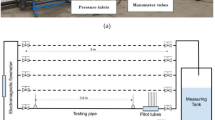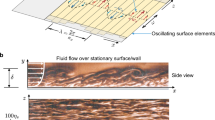Abstract
COSSAR has reported1 that the presence of a uniform layer of double-sided adhesive tape (‘Scotch’ brand) on the floor of a water channel can have a significant influence on the mean-velocity profile in the boundary layer of a turbulent flow. Indeed, Cossar's experiments indicate that, in his operating conditions, the velocity distribution above a layer of adhesive tape is almost the same as that obtained in flow over rough boundaries for which the mean height of roughness is about 0.040 inches (0.116 cm). He accordingly suggested that ‘Scotch’ tape is physically “sticky” towards water. But Cossar's interpretation of his results is open to question: it may be that, rather than increasing the resistance to the flow, the influence of the adhesive tape reduces it. This conclusion can in fact be inferred from Cossar's results. For flows past smooth boundaries, the shear stress τ exerted on the boundary is related to the viscosity η and the normal velocity gradient by  where u is the tangential velocity and y is the normal coordinate. But this is a good approximation only for boundaries that are hydraulically smooth, in the sense that the surface irregularities lie within the viscous sublayer of the flow. If, on the other hand, the roughness elements at the boundary are large enough, they can contribute to the shear stress exerted on the boundary through an effective form drag (see ref. 2, page 376), and then equation (1) is invalid. Indeed, it is usual for values of ∂u/∂y near the wall to decrease as the surface roughness increases (compare Cossar's results), although the actual shear stress exerted on the boundary increases. If we now make the assumption that the adhesive tape in Cossar's experiments was hydraulically smooth, it follows that the observed reduction in ∂u/∂y—which presumably extends right up to the wall—is accompanied by a reduction in shear stress, compared with what it would be on a smooth insoluble wall.
where u is the tangential velocity and y is the normal coordinate. But this is a good approximation only for boundaries that are hydraulically smooth, in the sense that the surface irregularities lie within the viscous sublayer of the flow. If, on the other hand, the roughness elements at the boundary are large enough, they can contribute to the shear stress exerted on the boundary through an effective form drag (see ref. 2, page 376), and then equation (1) is invalid. Indeed, it is usual for values of ∂u/∂y near the wall to decrease as the surface roughness increases (compare Cossar's results), although the actual shear stress exerted on the boundary increases. If we now make the assumption that the adhesive tape in Cossar's experiments was hydraulically smooth, it follows that the observed reduction in ∂u/∂y—which presumably extends right up to the wall—is accompanied by a reduction in shear stress, compared with what it would be on a smooth insoluble wall.
This is a preview of subscription content, access via your institution
Access options
Subscribe to this journal
Receive 51 print issues and online access
$199.00 per year
only $3.90 per issue
Buy this article
- Purchase on Springer Link
- Instant access to full article PDF
Prices may be subject to local taxes which are calculated during checkout
Similar content being viewed by others
References
Cossar, A. E., Nature, 227, 1044 (1970).
Goldstein, S., Modern Developments in Fluid Dynamics (Clarendon Press, Oxford, 1938).
Author information
Authors and Affiliations
Rights and permissions
About this article
Cite this article
BARNARD, B., PRITCHARD, W. Drag Reduction arising from Adhesive Tapes. Nature 232, 470–471 (1971). https://doi.org/10.1038/232470a0
Received:
Published:
Issue Date:
DOI: https://doi.org/10.1038/232470a0
Comments
By submitting a comment you agree to abide by our Terms and Community Guidelines. If you find something abusive or that does not comply with our terms or guidelines please flag it as inappropriate.



